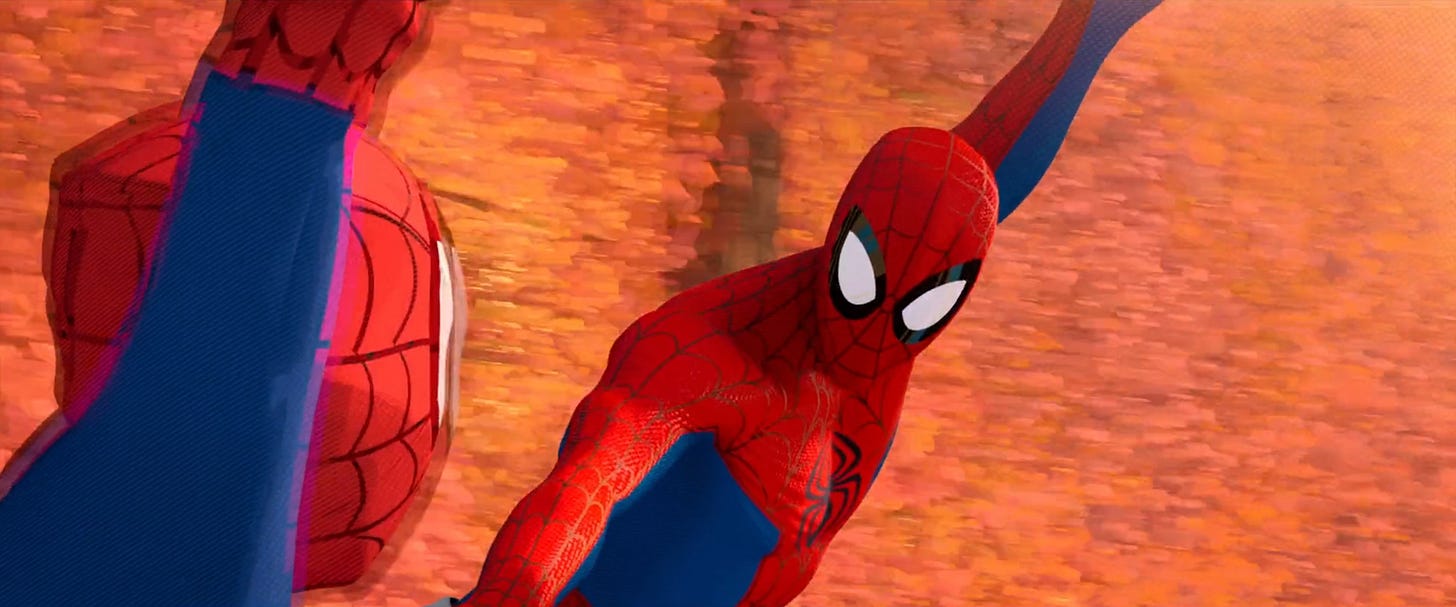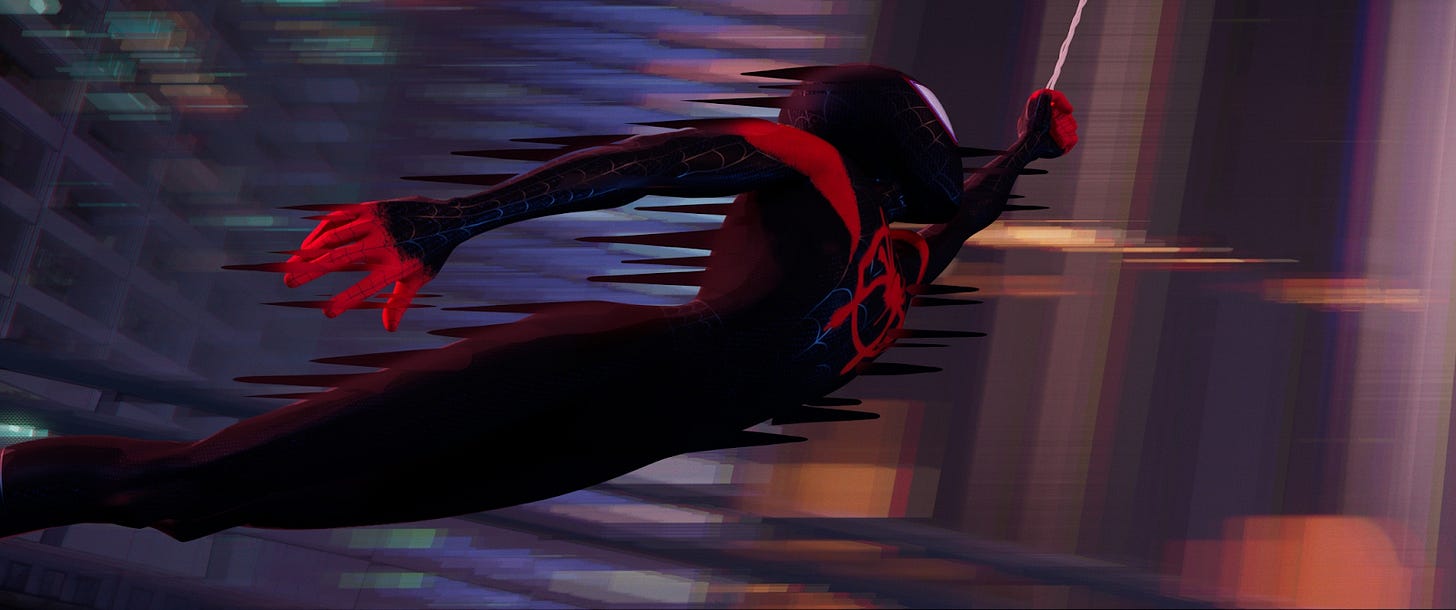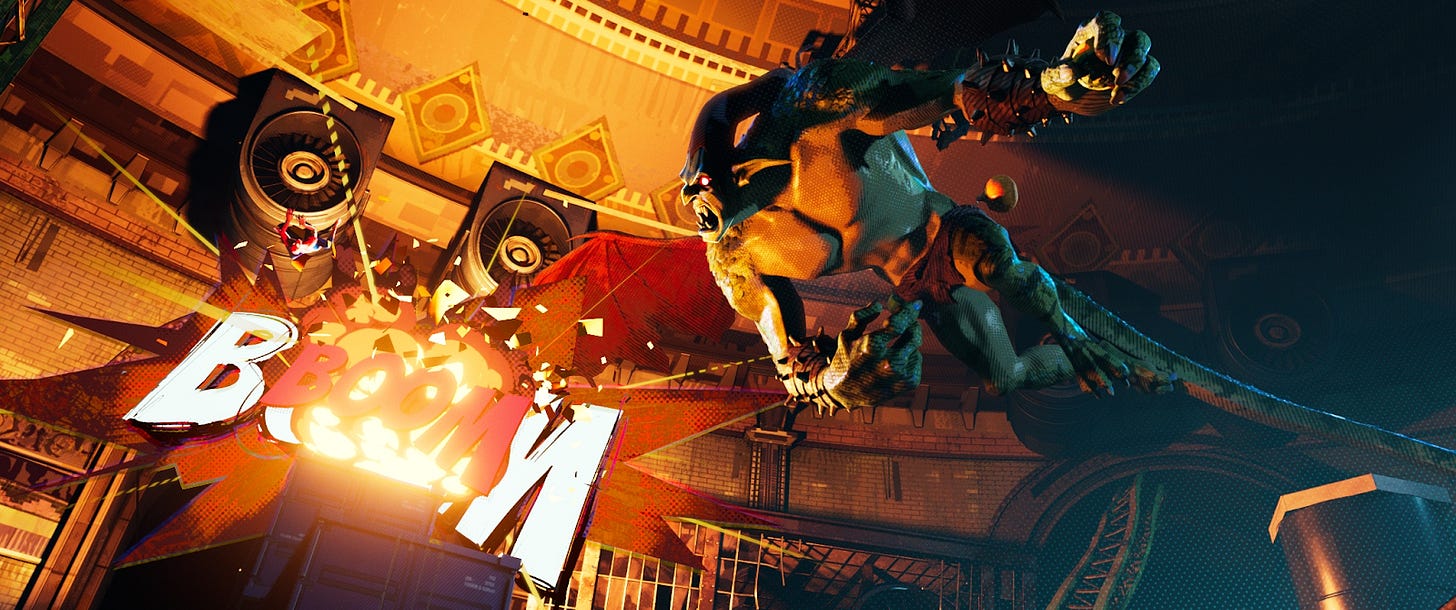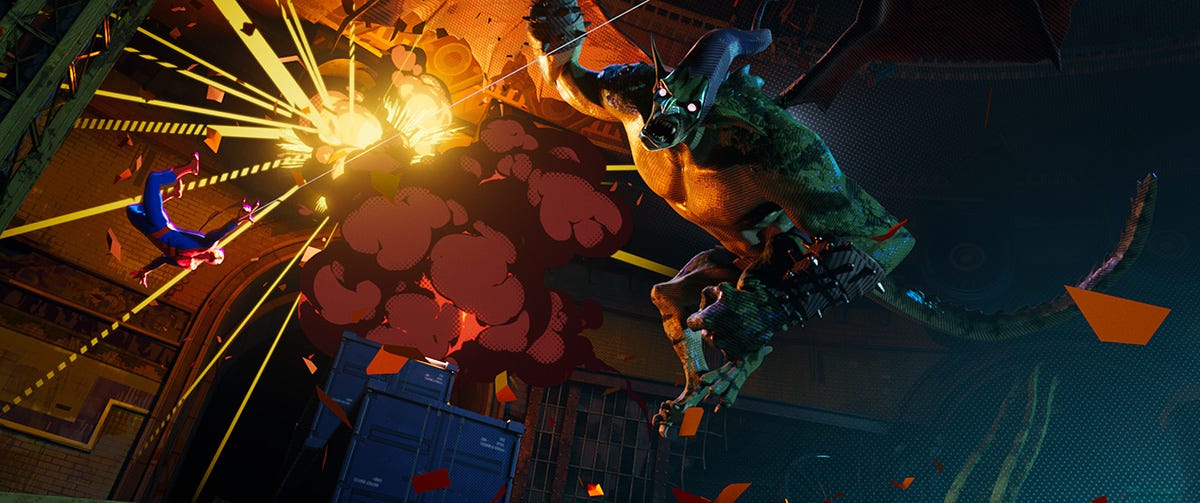*Warning, this article contains spoilers for Spider-Man: Into the Spider-Verse (2018)
Sony’s 2018 film Spider-Man: Into the Spider-Verse, hereafter ITSV, is an animated story of Miles Morales, a half African American half Puerto Rican kid from urban Brooklyn who loves art, science, hip hop, and family, who also takes on the mantle of Spider-Man.
It is one of the greatest animated superhero movies ever made.
It is one of the greatest superhero movies ever made.
It is one of the greatest movies ever made.
And why hasn’t the superhero industry produced more films of similar caliber to this masterpiece?
Every aspect of that movie is a game changer. ITSV should have ushered in a new age of innovation for the superhero industry. It is a gauntlet thrown down to the existing guard of Disney / Marvel, Warner Bros. Discovery / DC, and any other studio that seeks to capitalize on the superhero blockbuster renaissance that there is still new ground to be broken.
I certainly haven’t lost hope that more revolutionary content is on the way. After all, the sequel to ITSV, Spider-Man: Across the Spider-Verse, releases worldwide June 2023. What makes ITSV so innovative though, and what can other studios learn from it? I will humbly scratch the surface of some of the key elements that these other comic book competitors need reminding of: ITSV’s usage of music, the inventive style of animation, and a narrative that puts a fresh new take on an iconic comic book mythology.
Soundtrack
If somebody who has never seen ITSV listened to the original soundtrack created for the movie, that person would be listening to a critically acclaimed hip hop album with songs that have topped Billboard charts, and songs created by popular artists such as Jaden Smith, Nicki Minaj, Lil Wayne, Post Malone, and more. And if I told that person that the soundtrack was not only created for a superhero movie, but is a core part of the ethnic identity of the film, well I’d love to see the look on their face.
Music in movies, for any genre, superhero or otherwise, is inextricably linked as part of the narrative of the film. In that sense ITSV is not revolutionary. Though I would argue that prior usages of music in superhero movies have been more conventional. For example, there are numerous orchestral scores that have elevated the action themes of superhero movies such as Hans Zimmer’s composition for The Dark Knight trilogy. Or sometimes superhero films leverage existing popular songs to complement their story as demonstrated by James Gunn’s Guardians of the Galaxy and the three volumes of “Awesome Mix” tapes in that series.
Every once in a while there are original lyrical songs created for a superhero movie, but none with as much mainstream commercial appeal as ITSV’s soundtrack. "Sunflower" by Post Malone and Swae Lee is a chart topping hit and Miles Morales’ anthem. Miles is introduced to audiences humming to this rap, and he even evokes it in times of stress to calm him down. "Familia" by Nicki Minaj and Anuel AA featuring Bantu with its reggaetón beats highlight the Puerto Rican half of Miles’ identity.
In addition to the lyrical songs, the score is just as inventive as the rest of the movie. The soundscape of ITSV blends a variety of hip hop elements from trap beats, turntable scratching, EDM, reggae, and more to create a score that amplifies the ethnic identity and pop culture elements of the film.
ITSV has essentially turned its music into comic book and superhero content. The more synergistic content one can create in different forms based on superhero intellectual property, the more effective you’re able to engage existing fans in holistic ways and acquire new fans. I call this framework - the Superhero Flywheel - and I go into more detail on its construction in my previous post: Superhero Flywheel, Up, Up, and Away.
You may notice though that I do not include music as a key component of the Superhero Flywheel and that is deliberate. It is uncommon to have true original soundtracks in a comic book or superhero movie that can stand alone and penetrate mainstream tastes. But that is not the case for ITSV!!
The way Sony has been able to effectively expand the scope of the flywheel is no coincidence. There are three big major record labels in the U.S. - Universal Music Group, Warner Music Group, and Sony Music Group. Music is one of Sony’s strongest differentiators relative to other studios that produce superhero content. Interestingly, the soundtrack for ITSV was co-produced by Sony and Republic Records (which is part of Universal Music Group). I commend Sony for partnering on this endeavor because it was clearly the right strategy. Instead of utilizing artists exclusive to the Sony label, they prioritized choosing the right artists to fulfill their musical vision which meant working alongside Republic Records and the artists they were able to source.
As a result, fans that love the movie can go listen to and buy the album, those that may not have seen the movie but have listened to the songs could go watch ITSV, or anybody can just enjoy the album by itself. This is the power of the best hip hop film soundtrack ever created for a superhero movie.
Animation
ITSV is a living comic book. An animation so innovative the incredibly talented team at Sony Pictures Imagework, the visual effects and computer animation studio that brought this movie to life, invented a new visual language in order to tell Miles’ story. I can’t do the explanation of the visual style justice. For that topic, I highly recommend this blog post by Sony Pictures Imagework detailing some of the technical elements of the film: Sony Pictures Imageworks - Spider-Man: Into the Spider-Verse.
Instead, I just want to touch on some of the visual details that I find particularly inventive, and also permeate the film. There are so many animation elements ITSV introduces that are imperceptible at first glance, but really define the dynamic kineticism of the movie.
One clever effect the team implemented was varying the frame rate between different characters. The other Spider-variants that Miles meets move at 24 frames per second, which is the most common for animation, whereas Miles moves at a slower 12 frames per second. An example of this can be seen when Miles and Peter B. Parker escape from their infiltration of Fisk’s research facility, Alchemax, and are being pursued by Dr. Olivia Octavius in the forest.
Here you can see some lag in Miles relative to Peter. When Miles finally hones his power towards the climax of the film, he then begins to move at 24 frames per second! The team has taken an element that is so basic to animation, but utilizes it to metaphorically communicate Miles' ascension to Spider-Man.
Continuing on the topic of motion, given the blend of 2D and 3D elements, ITSV sought to bring more principles from comic books into how they depict motion. The team utilizes a mix of techniques including smearing the geometry, drawing speed lines, and the use of multiple character limbs.
The last element I want to highlight are the comic panel flashes that occur frequently throughout the movie, but sometimes only for a split second. Even so it does such a great job imprinting another level of dynamism to the scene.
In this scene, Miles is running from The Prowler after the death of Peter Parker. As he jumps the subway track, there’s a momentary flash of the subway’s headlights speeding towards Miles in comic art before he reaches the other side of the tracks. ITSV spontaneously slips in comic image stills into the entire frame as a way to accentuate tension or emotions.
During the fight between Spider-Man and Green Goblin, this frame perfectly encapsulates the blending of 2D and 3D elements with hand drawn images to create a comic panel splash effect in the explosion. As a lifelong comic reader, ITSV warms my heart as it pays tribute to comic book imagery, and introduces non-comic fans into this style through their visionary aesthetic.
The key to developing this visual style lies in several core tenants of innovation strategy - taking risks and nurturing creativity. In an interview with ITSV visual effects supervisor Danny Dimian puts it best1:
“trying to do something a different way, even if there was no real reason for it. We wanted to change the term, ‘If it’s not broke, don’t fix it’ to, ‘If it’s not broke, break it.’ The goal was to encourage people to experiment and to play in hopes of finding new ideas.”
Narrative
There is no better narrative vehicle to depict a coming-of-age story than utilizing one of the most iconic superheroes of all time that embodies that trope - your friendly neighborhood Spider-Man. This story isn’t the umpteenth rehash of Peter Parker’s origin story. *At least not exclusively, ITSV comically pokes fun at the traditional origin in one of its many delightfully meta moments.
Miles’ rendition has all the cornerstones of the Spider-Man story: family, identity, maturation, and heroism. The fresh take that ITSV brings is that it tells this tale across the multiverse, and it highlights an integral theme that is part of growing up, which is mentorship. Because even though one recognizes that with great power comes great responsibility, doing so can be daunting, especially when the stakes are so high for failure, especially when you’re young, and especially when you feel alone…
Before the Marvel Cinematic Universe’s Spider-Man: No Way Home (2021), Doctor Strange in the Multiverse of Madness (2022), any of the entrants in the MCU’s Multiverse Saga, or DC’s The Flash (2023), in 2018, unsurprisingly ahead of its time, ITSV is the first successful superhero movie about the multiverse. The movie has a roster of Spider-Variants, all who have experienced tragedy in their backstories as they grew into becoming Spider-Heroes.
Mentorship is woven into their respective coming-of-age stories, and doing so brings a variety of representations of the human condition. Miles Morales, an urban ethnic kid feels culturally out of place in his elitist school, struggles to connect with his father, and seeks guidance through his villainous Uncle Aaron, his universe’s Peter Parker, and Peter B. Parker to reach his potential. Gwen Stacy, Spider-Woman, who lost her universe’s Peter Parker, her best friend, but carries his memory with her. Peter B. Parker, a disillusioned and depressive Spider-Man in his adulthood who drove Mary Jane away because he was afraid of starting a family with her. Who ultimately develops a sense of parenthood through his mentorship of Miles. The essence of Spider-Man and his journey of maturation is why he is one of the most popular and greatest heroes in the superhero pantheon, and through ITSV’s multiverse, that throughline is honored and deeply enriched.
The telling of the origin stories, especially in the age of reboots and the building of superhero franchises, is unavoidable. But that doesn’t mean it needs to be formulaic, audiences are most likely fatigued from that anyways. ITSV is a reminder that in the rich tapestry of these superhero mythologies, a lack of narrative creativity is never an excuse as you weave the next story.
--
What I just outlined is merely a whisper in the loud wake-up call that ITSV should have been to the superhero industry! If you need a different reminder and a more succinct demonstration of what I just wrote about, I encourage you to watch the two minute scene that kicks off the film’s climax (linked below). When Miles comes into his own identity as Spider-Man, customizes his suit, and swings into action. Bask in how this moment captures everything that I’ve just mentioned - original hip-hop music, inventive animation, mentorship narrative - and how it so quintessentially represents the special quality of Miles Morales as Spider-Man.
If you get chills, that’s just your spidey sense tingling to alert you of a visionary work of innovation. Go watch Spider-Man: Across the Spider-Verse, and let’s hope we don’t have to scour the multiverse to get more art like this.















